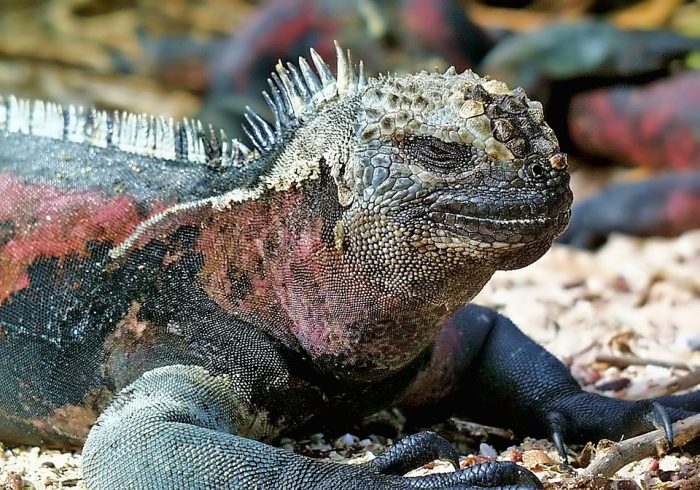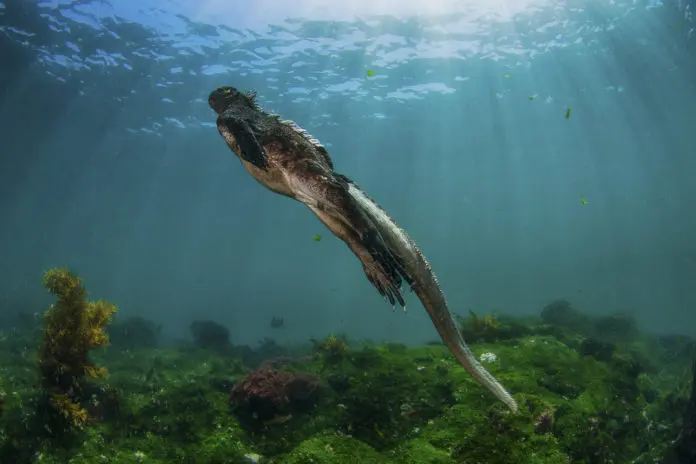The Galapagos Islands have many world-class dive sites to choose from and offer remote diving surrounded by wildlife found nowhere else on earth. It is an ideal diving destination for nature lovers and divers can enjoy seeing penguins, sea lions, eagle rays, manta rays and numerous sharks, including silky, Galapagos, blacktips, and schools of hammerhead sharks. One of the more unusual creatures to enjoy whilst diving in the Galapagos is the ancient marine iguana.
What Are Marine Iguanas?
Galapagos marine iguanas are the world’s only marine lizard and are only found at the Galapagos Islands. They have the unique ability to forage in the sea and have successfully adapted to the harsh marine environment of the islands.
When Did Marine Iguanas First Appear?
The Galapagos Islands have never been attached to a land mass, so it is thought the Galapagos iguanas rafted to the islands from South America 10 to 15 million years ago. The marine iguana separated from land iguanas at the Galapagos around 8 to 10 million years ago, which is older than any of the Galapagos islands visible today. It is thought the marine iguanas used to live on parts of the Galapagos archipelago that are now underwater.
Are Marine Iguanas at Risk of Extinction?
Marine iguanas have a small range and are listed as vulnerable to extinction by the IUCN. Main threats to their survival include introduced predators such as cats, rats, and pigs, plus the impacts of climate change. Changes in the global climate affect the iguanas’ beach nesting habitat and the ability to regulate their body temperature on land. Changes in weather patterns also affect the iguanas by reducing the availability of the algae they feed on.

Marine Iguana Fun Facts
- They are perfectly adapted for life in the ocean. They have evolved blunt noses for grazing on algae, flattened tails to assist swimming, and strong claws for clinging to rocks washed by ocean swells
- Marine iguanas can be colorful depending on what they eat. They are mostly black but have blotches of green and red on their bodies during the mating season, thought to result from eating a particular type of algae that blooms during the summer months
- They are not very agile on land but make up for that by being excellent swimmers
- They can sneeze salt out of their noses. Their diet is very high in salt and marine iguanas filter their blood at the nose and sneeze out the excess salt, often resulting in salt crystals forming on the end of their snouts
- They are great divers and can dive for up to 10 minutes at a time to feed
- Their heartbeat slows to half its normal pace underwater, allowing them to dive for as long as possible
- Despite being generally unsociable, they huddle together at night for warmth and bask in the morning sun to gain the energy they need to forage
Where Can Divers See Marine Iguanas?
Marine iguanas can be seen in the coastal regions on the islands of Isabela, Fernandina, Española, Santa Cruz and Floreana. They live on the islands all year and their mating season occurs between January and March. They are active during the day and divers can get in the water with these fascinating creatures. Capo Douglas liveaboard diving on the eastern side of Fernandina Island offers shallow dives, where divers can encounter feeding marine iguanas underwater at 5 to 10 meters (16 to 32 feet) depth. It is advisable to wear gloves when diving with the iguanas, as the swell can be very high close to shore.
When Is The Best Time For Diving In The Galapagos?
Diving in the Galapagos is possible all year and there are two main seasons. The wet season of January to June offers warmer water, with January to May being a good time to visit for mantas and hammerheads. The dry season of July to December offers the best chance of seeing whale sharks and is usually busier, though can be rougher at sea. May is a great month to visit for sunny skies, calm seas and water temperatures of 20 to 25 ºC (68 to 77 ºF).

